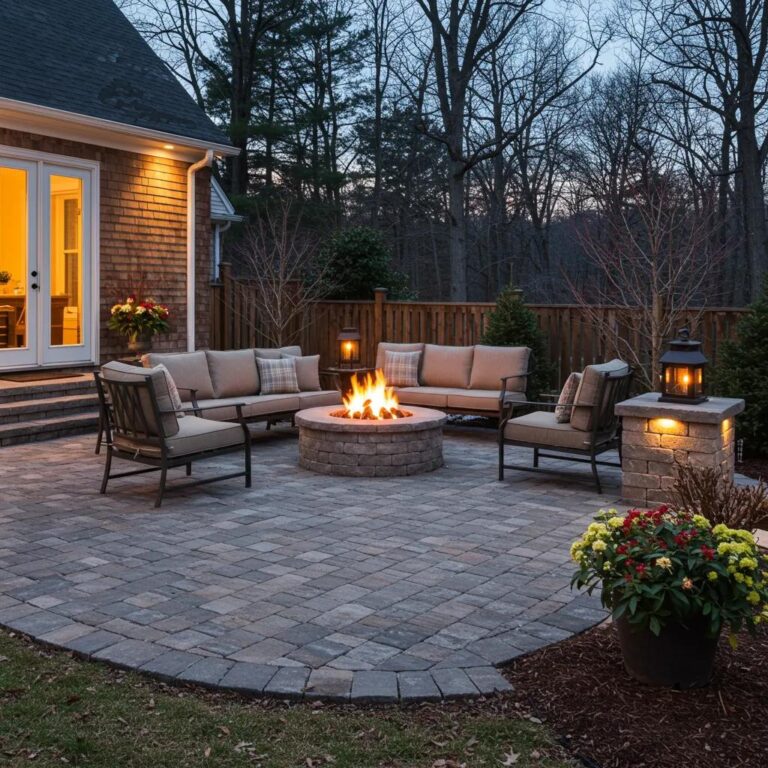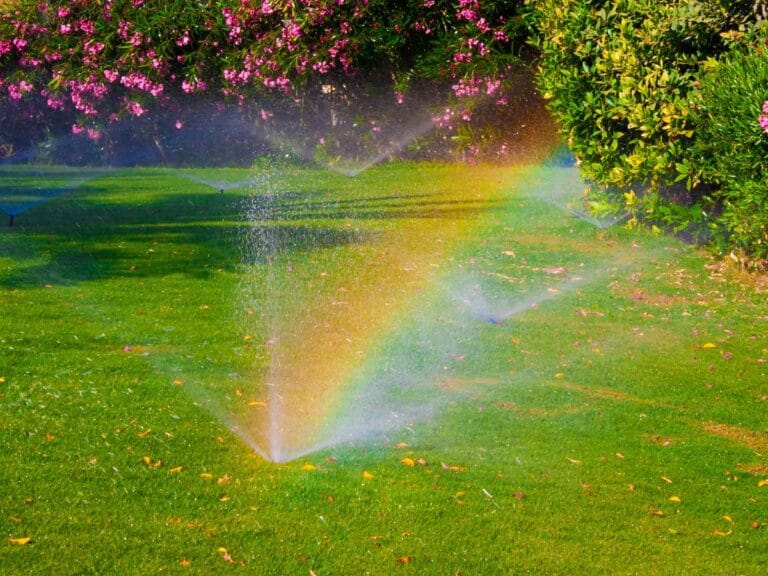Atlanta homeowners face unique challenges when maintaining their decks due to the city’s fluctuating weather patterns and high humidity. Proper deck care is essential both for aesthetic appeal and long-term durability. This article provides seasonal deck maintenance tips to protect your deck from Atlanta’s climate. You will find practical guidelines on cleaning, applying protective sealants, performing repairs, managing pests, and accessing professional services, all designed to prolong the life of your deck and enhance curb appeal.
Avoid Costly Repairs with These Deck Maintenance Tips for Atlanta
Understanding Atlanta’s Climate Impact on Your Deck
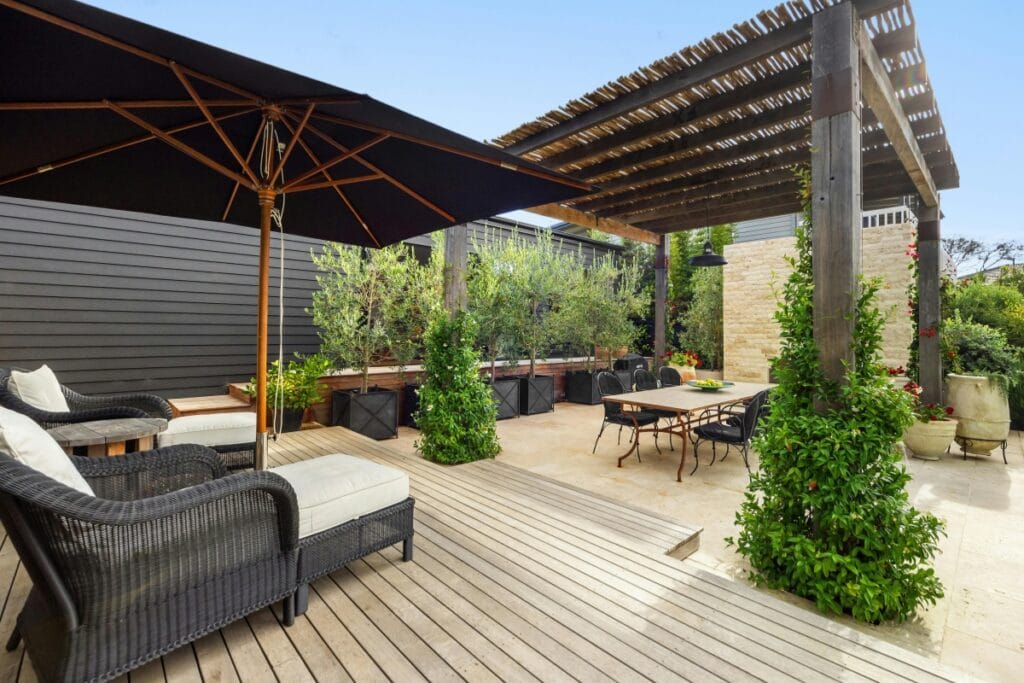
If you live in the Atlanta area, you know how the weather can shift quickly—from humid summers to wet winters and everything in between. While the climate adds to the region’s charm, it can also take a toll on outdoor structures, especially decks. High humidity, frequent rainfall, and seasonal temperature swings can lead to mildew, rot, surface fading, and even structural damage if your deck isn’t maintained properly. Understanding how local weather affects different decking materials helps you stay ahead of problems before they turn into expensive repairs.
How Humidity Affects Deck Materials in Georgia
Humidity is one of the biggest challenges for deck owners in the South. When moisture levels in the air stay high for extended periods, wood tends to absorb that moisture. Over time, this can lead to warping, swelling, and weakening of fasteners like screws and nails. You might also notice boards starting to cup or splinter, making your deck less safe to walk on.
Decks made from untreated or poorly sealed wood are especially vulnerable. A regular inspection routine is important, particularly in the spring and summer months when humidity peaks. Look for soft spots, dark patches, or boards that feel loose underfoot. To extend the life of your deck, consider upgrading to composite decking materials or reapplying a water-resistant sealant every one to two years.
Preparing Your Deck for Hot Atlanta Summers
The summer heat in Atlanta is no joke. High temperatures and intense sunlight can quickly fade deck stains and dry out wood surfaces, leading to cracks and surface peeling. Dirt and grime also build up faster during this time due to foot traffic and outdoor activities.
Before summer arrives, pressure wash your deck to remove any built-up debris, but keep the pressure setting low to avoid damaging the wood. Use a mild detergent suitable for your deck’s material. Once clean, apply a UV-resistant sealant or stain to help block out harmful rays and lock in moisture. If your deck gets full sun exposure during the day, adding a pergola, shade sail, or even large outdoor umbrellas can protect both your deck and your comfort.
Protecting Your Deck During Mild Southern Winters
Atlanta winters are usually mild, but temperatures can still dip below freezing. Those occasional freeze-thaw cycles may not last long, but they can still cause damage to your deck over time. When water gets into small cracks or unsealed wood, it expands as it freezes, leading to splintering or more serious structural damage.
After heavy rain or light snow, it’s a good habit to clear standing water or slushy buildup with a broom or soft brush. Avoid metal tools or shovels that can gouge the surface. Before winter begins, apply a flexible winter-ready sealant that can handle cooler temperatures without cracking or peeling.
Managing Pollen and Organic Debris Accumulation
Spring in Atlanta brings heavy pollen, which can coat your deck in a yellow film. Left untreated, pollen combines with moisture and organic debris like fallen leaves to create the perfect breeding ground for mildew and algae.
To prevent buildup, sweep your deck regularly—especially during spring and fall. Use a soft-bristle broom or sponge mop along with a gentle, biodegradable deck cleaner to remove residue without damaging the surface. Stay away from bleach-based products unless absolutely necessary, as they can strip away finishes and dry out wood. Keeping gutters and nearby trees trimmed also reduces the amount of debris that lands on your deck.
By staying proactive with seasonal maintenance and using the right tools and treatments, you can keep your deck looking good and performing well, no matter what Atlanta’s weather throws your way.
Spring DeckMaintenance Checklist for Atlanta Residents

As temperatures start to rise, spring becomes the perfect time to get your deck back in shape after winter. A little attention now can prevent bigger problems down the line and help you enjoy your outdoor space all season long.
- Start with a Post-Winter Inspection: Cold weather and moisture can take a toll on your deck. Begin by checking for visible signs of wear, especially around joints, railings, and where the deck connects to the house. Look for cracks, splintering, loose boards, and any fasteners that may have worked their way out. Take note of any mold or mildew buildup, as this can spread if left untreated. Spotting problems early lets you plan for minor repairs before they turn into costly issues.
- Clean Off the Winter Grime: Once the inspection is done, give the deck a solid cleaning. Use a soft-bristle brush or sponge and a mild detergent to scrub away dirt, dust, and pollen. Pay close attention to corners and tight spaces where debris tends to collect. If your deck has stubborn stains or algae buildup, you can use a pressure washer on a low setting. Be careful not to strip the wood or cause splintering—slow, steady passes work best.
- Refresh with Sealant or Stain: After the deck dries completely, apply a new coat of sealant or stain. This step helps protect the surface from rain, sun, and humidity throughout the warmer months. Choose a product that’s designed to withstand moisture and UV exposure, and apply it evenly using a roller or brush. A good sealant keeps water out and makes cleaning easier down the road.
- Tighten Railings and Replace Damaged Boards: Check railings and boards for movement or gaps. Use a screwdriver or drill to tighten screws and bolts. If you find warped or rotting boards, replace them right away to keep the deck safe and sturdy.
- Get the Space Ready to Enjoy: Clear the area of any leftover winter clutter. Trim overhanging branches and clean outdoor furniture. A few updates—like fresh mulch around the base or new string lights—can help your deck feel clean, refreshed, and ready for spring gatherings.
Summer Deck Care Strategies in the Atlanta Heat
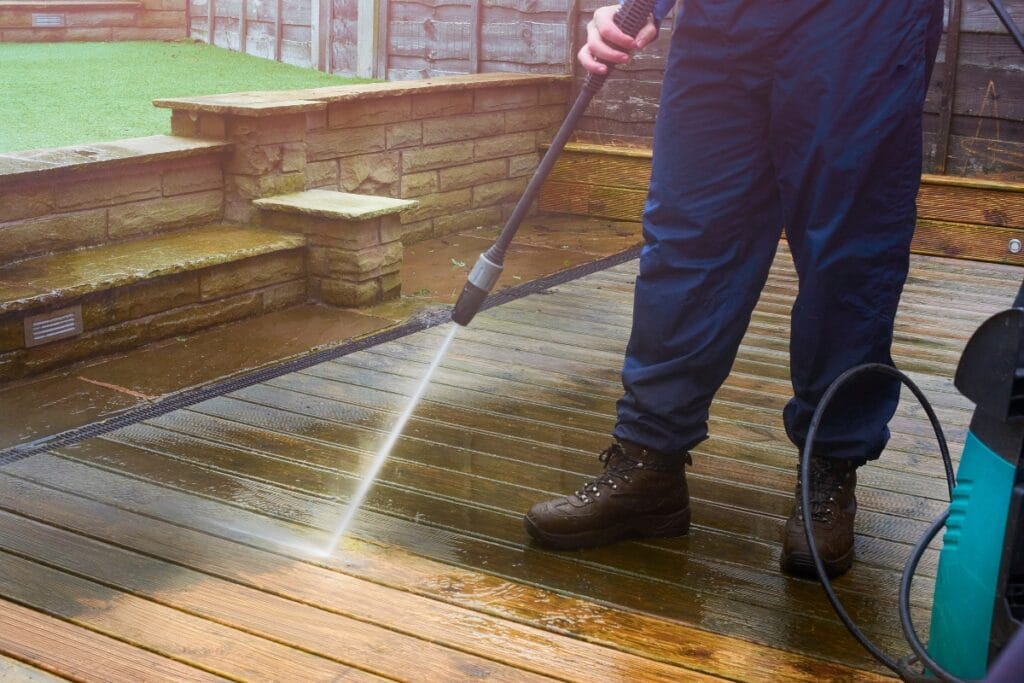
Atlanta summers can be brutal on decks. High heat, strong sun, and humidity all take a toll. Keeping your deck in good shape means tackling a few seasonal challenges head-on.
- Keep the Sun from Fading Your Deck: Direct sunlight can cause wood stains and sealants to fade quickly. A good first step is to set up some shade. Pergolas, retractable awnings, or even large patio umbrellas can help block UV rays. Look for deck stains or sealants that contain UV protection, and reapply as needed—usually every one to two years. Even placing a few large potted plants or using shade sails can help reduce exposure.
- Clean Often to Stop Mold and Mildew: Warm, humid air makes it easy for mold and mildew to form, especially in shaded or wet spots. Give your deck a light cleaning every couple of weeks. Use a garden hose with a spray nozzle and a mild soap solution. A soft-bristle brush can help scrub away any buildup without damaging the wood or composite material. Stay ahead of algae and grime so they do not become long-term problems.
- Water Plants Without Soaking the Deck: Water from planters or hanging baskets can pool underneath and damage the wood or finish. Make sure watering cans or hose settings direct water into the soil, not over the side of the pot. Consider using drip irrigation or trays under planters to catch runoff. Also, check between deck boards and keep gaps clear to encourage proper drainage.
- Shading Helps with Comfort and Longevity: Besides reducing sun damage, shade makes the deck more usable. Surface temperatures can drop significantly when shaded, making it easier to walk barefoot or host guests. Whether you choose temporary options like freestanding umbrellas or invest in permanent features like pergolas, the added comfort is worth it.
- Grill Smart to Avoid Damage: Grilling is a summer staple, but it can leave permanent marks if you’re not careful. Place your grill on a heat-resistant mat, and never leave it unattended. Wipe up spills quickly, especially grease. Make sure your grill has a heat shield and is set up on a surface that won’t catch fire or leave stains.
- With these habits in place, your deck can stand up to summer and stay ready for relaxing, entertaining, or just enjoying the warm weather.
Autumn Deck Preparation for Cooler Atlanta Weather

As temperatures drop and rain becomes more frequent, fall is a good time to get your deck ready for winter. Taking care of a few key tasks now can help you avoid bigger problems later.
- Clear Leaves and Debris Regularly: Fallen leaves and organic material can stain your deck and trap moisture, leading to mold or mildew. Sweep the surface with a soft broom or use a leaf blower on a low setting. Don’t forget to clean between the deck boards—wet leaves left in those gaps can cause rot over time.
- Inspect and Repair Before Cold Weather Hits: Look over your deck for any signs of wear. Check for loose nails, cracked boards, or wobbly railings. These issues tend to get worse in winter when moisture freezes and expands. Replacing damaged boards or tightening screws now can save you the cost of larger repairs down the road.
- Apply Water Repellent Sealant: Before fall rains set in, apply a fresh coat of water-repellent sealant. This helps prevent the wood from soaking up moisture, which can lead to swelling, warping, or mold. Look for a product that also includes UV protection so the finish holds up against sun exposure through early winter.
- Protect or Store Your Furniture: Outdoor furniture left out in the elements can damage your deck by trapping moisture or scratching the surface during strong winds. Store furniture in a shed or garage if possible. If not, use weatherproof covers to keep it protected.
- Trim Back Trees and Shrubs: If you have overhanging branches or nearby bushes, fall is a good time to trim them. This helps reduce the number of leaves falling on your deck and lowers the chance of branches snapping during a storm and causing damage.
A little maintenance now makes a big difference when winter hits. With a clean surface, repaired boards, and proper protection in place, your deck will be ready to handle whatever the season brings—and you’ll be one step ahead for spring.
Winter DeckMaintenance Essentials in Atlanta

Even though winters in Atlanta are relatively mild, your deck still needs attention to stay in good shape through the colder months. Winter care is mainly about managing moisture, avoiding damage from freezing and thawing, and keeping everything safe and functional until spring.
- Remove Snow and Ice Safely: When frost or light snow hits, it’s important to clear it without causing damage. Use a soft-bristle broom or a plastic shovel to gently remove snow buildup. Avoid metal shovels and don’t chip away at ice, as this can gouge or crack wooden boards. If needed, use warm water to melt small patches of ice, but make sure to dry the area afterward.
- Watch for Moisture Problems: Keep an eye on areas where moisture tends to collect, such as between deck boards and under railings. Trapped water can lead to mold, mildew, and even wood rot if not addressed. Clear leaves and debris that block drainage and check for signs of soft or discolored wood. Standing water should be removed quickly to prevent long-term damage.
- Minimize Freeze-Thaw Damage: Atlanta’s occasional freeze-thaw cycles can cause wood to expand and contract, which leads to cracks over time. A good water-repellent sealant helps reduce this risk. If your deck was sealed earlier in the year, do a spot test—splash a little water on the surface. If it beads up, the sealant is still working. If it soaks in, it’s time to reapply.
- Maintain Proper Drainage: Make sure your gutters and downspouts are working properly and that water is flowing away from the deck. Clogged gutters can overflow, leading to puddles on your deck surface. Sweep off pine needles, leaves, and anything else that could block water from draining. Trim nearby shrubs and branches to keep debris to a minimum.
- Use Winter to Plan for Spring: Winter is also a good time to take stock of your deck’s condition. Make a list of repairs or upgrades you want to tackle when the weather improves. Identifying issues now means you can get a head start on spring maintenance, which helps your deck stay in great shape year-round.
Essential Deck Cleaning and Upkeep Practices
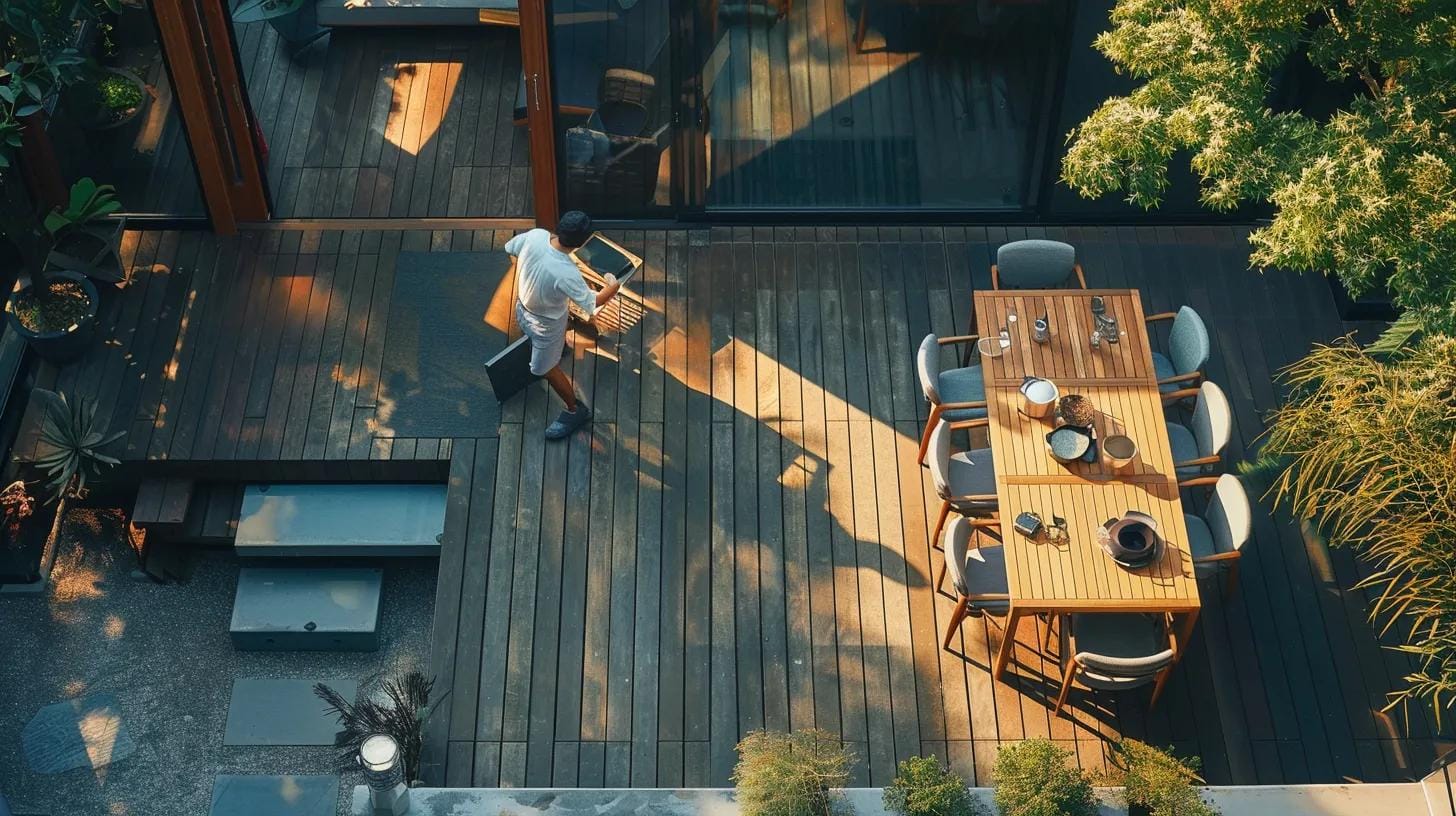
Keeping your deck clean isn’t just about appearances—it’s also about safety and longevity. Mold, mildew, and dirt buildup can cause slippery surfaces and long-term damage if ignored. A consistent cleaning routine helps prevent these issues and keeps your deck in good condition throughout the year.
- Use the Right Cleaning Products for Your Deck: Different deck materials call for different cleaning solutions. For wood decks, choose a mild, eco-friendly detergent that won’t strip away natural oils or damage the grain. Composite decks can usually handle stronger cleaners, but it’s still important to check the label and follow manufacturer guidelines. No matter the product, always test a small, hidden section first to make sure it won’t discolor or damage the surface.
- Power Washing Without Damaging the Surface: Power washing can be an efficient way to clean, but it needs to be done carefully. Use a low-pressure setting with a wide fan nozzle to prevent gouging or removing protective sealant. Hold the wand a safe distance away—usually around 12 to 18 inches—and move in smooth, overlapping passes. Avoid concentrating the spray in one spot for too long.
- Sweep Regularly and Clean Spills Right Away: Frequent sweeping helps stop dirt and organic debris from accumulating, especially in the corners and between boards. Use a soft-bristle broom that won’t scratch the surface. If something spills, clean it up immediately with a sponge and a mild soap and water mix. Letting liquids sit increases the chance of staining and mold growth.
- Tackle Stains Before They Set In: If a stain does develop, blot it instead of scrubbing to avoid damaging the deck’s finish. A dedicated cleaning kit with rags, mild cleaner, and a bucket can make quick cleanups easier. Spot-cleaning as soon as an issue arises can save time and prevent bigger problems later.
- Don’t Ignore the Gaps Between Boards: Debris that gets stuck between deck boards can trap moisture and lead to mildew or even rot. Use a stiff brush or outdoor vacuum to clear out these spaces on a regular basis, especially after storms or during fall.
A little upkeep goes a long way. With the right tools and a routine in place, your deck will stay clean, safe, and ready to use.
Staining and Sealing Your Atlanta Deck for Longevity
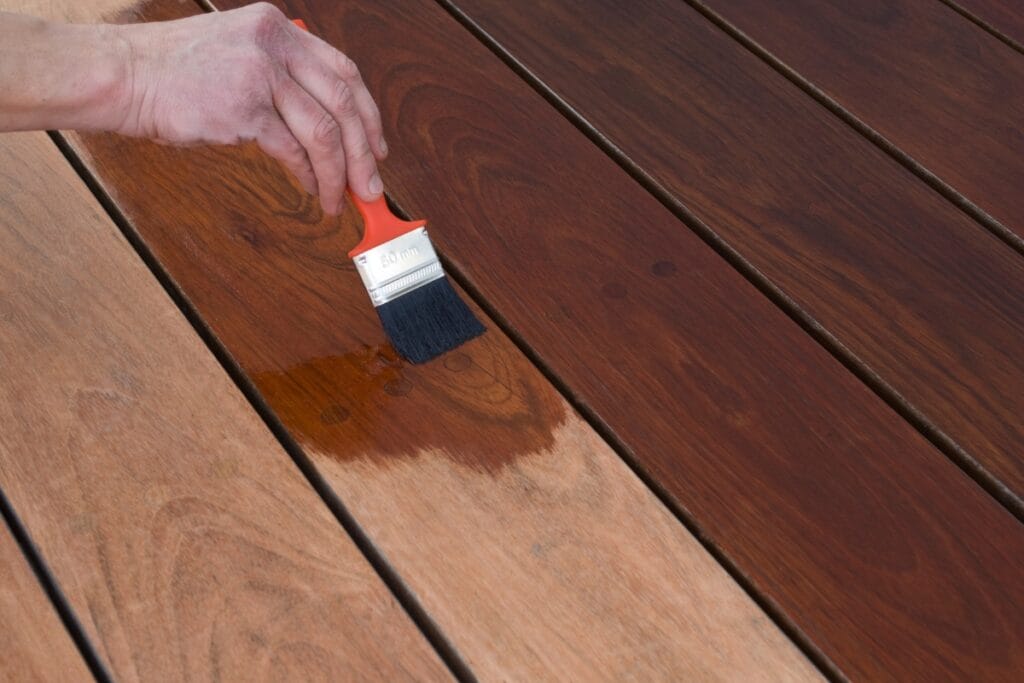
If you want your deck to last through Atlanta’s changing weather, staining and sealing are a must. These steps protect your deck from moisture, sun damage, and general wear and tear. Without proper treatment, wood can crack, fade, or grow mold over time.
- Choosing the Right Stain or Sealant for Georgia Weather: Atlanta’s climate can be tough on outdoor wood. Look for products that offer both water resistance and UV protection. Many quality sealants now combine oil- and water-based properties, allowing them to sink deeper into the wood and hold up better against humidity and heat. Some even include mildewcides to help keep fungal growth in check.
- Best Time of Year to Stain Your Deck in Atlanta: Spring and early fall are the best times to stain or seal a deck in this region. You’ll want mild temperatures, low humidity, and dry conditions for the product to cure properly. Avoid staining during the peak of summer or right before heavy rain. A stretch of two to three dry days is ideal.
- Prepping the Deck Surface the Right Way: Before you apply anything, start with a clean deck. Use a cleaner that’s safe for your deck material, followed by a light power wash to remove dirt and residue. If the wood feels rough or has old stain left behind, sand the surface lightly to help the new product stick. Make sure to fix any damaged boards beforehand.
- How to Apply for Even Results: Use a roller or a wide brush to apply the stain or sealant in thin, even coats. Don’t overload the brush or roller—too much product can lead to blotchy spots or long drying times. Follow the product’s instructions on how long to wait between coats, and give it time to fully dry before placing furniture back on the deck.
- When to Reapply and What to Watch For: Plan to re-stain or reseal your deck every two to three years. If you notice fading, water soaking into the boards, or rough patches, it’s probably time for a fresh coat. Staying on top of maintenance keeps your deck looking great and prevents larger repairs down the road.
Common Deck Repairs and When to Address Them
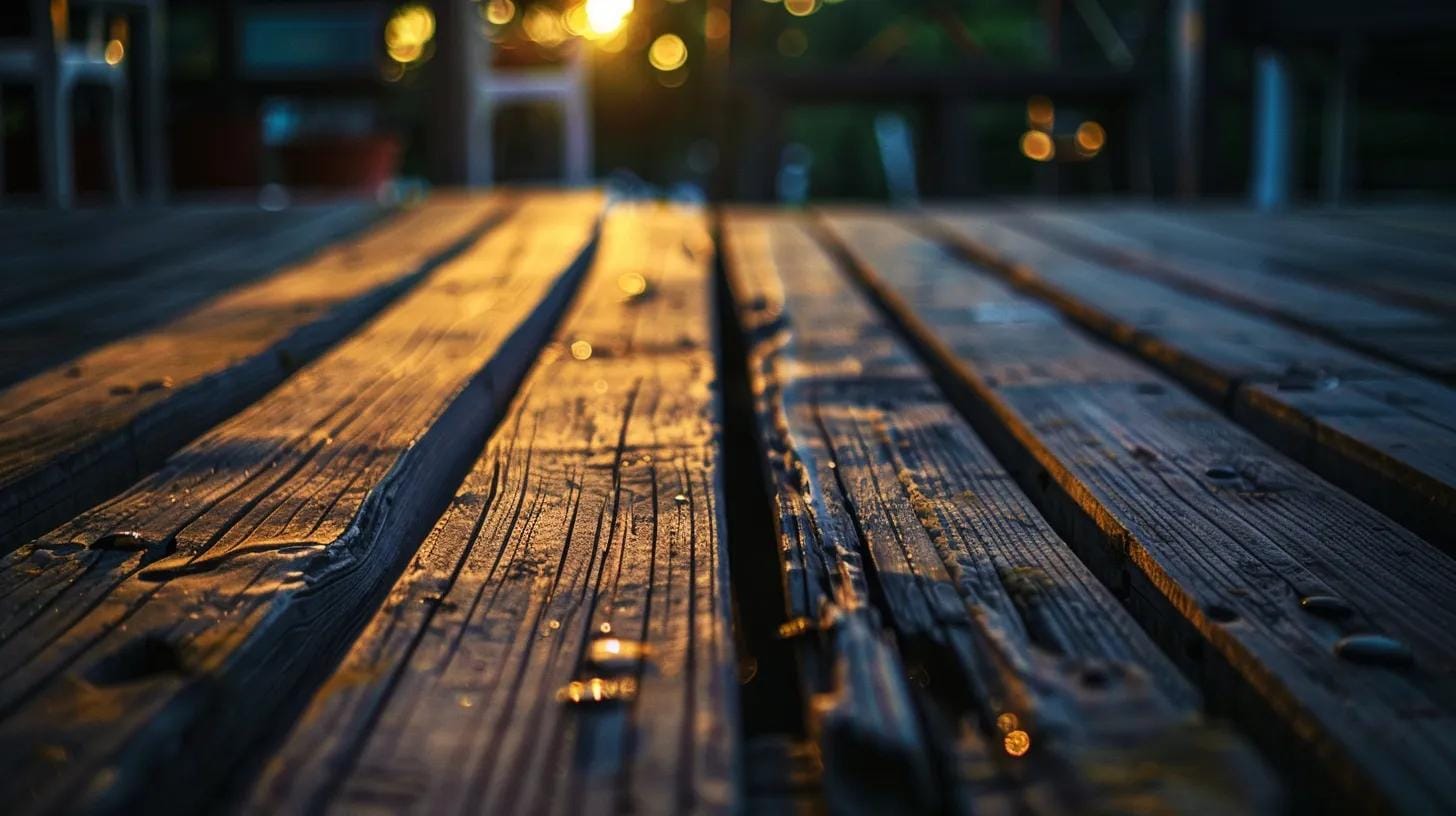
Taking care of minor deck issues early helps avoid bigger problems down the road. Whether it’s soft wood, loose hardware, or wobbly railings, routine repairs help keep your deck both safe and good-looking.
- Spotting and Replacing Rotted or Damaged Wood: Start by checking for signs of rot. Look for soft spots, dark stains, or any areas that give under pressure. You might also notice a musty smell, which can signal moisture damage. If you find rotted boards, replace them with pressure-treated lumber rated for outdoor use. This keeps the structure strong and prevents the damage from spreading.
- Tightening or Swapping Out Loose Fasteners: Over time, nails and screws can work their way out due to temperature changes or daily use. If you find any that are sticking out or rusted, replace them with stainless steel or coated deck screws. These materials hold up better against weather and keep your deck solid and secure.
- Fixing Unsteady Railings: A loose railing is not just annoying—it’s a safety hazard. Give your railings a firm shake to check for movement. If they wobble, inspect the posts and connection points. Tighten the fasteners or install new hardware if necessary. For wood that’s cracked or soft at the joints, replacement may be the better option.
- Dealing With Popped Nails or Screws: Popped fasteners are easy to overlook but can lead to moisture seeping into the wood. This can create long-term damage. Pull out any loose nails, and replace them with properly sized screws to keep everything tight and water-resistant.
- Sanding Down Splinters and Rough Patches: Splintered areas not only look rough, but they can also be painful if someone walks across the deck barefoot. Use a sanding block or power sander to smooth down problem spots. For larger splits, fill cracks with wood filler rated for outdoor use. If many boards are splintered or starting to split, replacement may be more efficient.
By staying ahead of these common issues, you can extend the life of your deck and make it a safe place for family and guests to enjoy year-round.
Pest Control for Your Atlanta Deck Area

Keeping pests under control around your deck is important not just for comfort, but also for protecting the structure and surrounding landscaping. Regular checks and smart prevention go a long way toward avoiding expensive damage.
- Termite Prevention for Wooden Decks: Termites are one of the biggest threats to wooden decks in the South. Do routine inspections by checking under the deck and around support posts for mud tubes or soft, damaged wood. Apply a wood preservative or termiticide to deter them, especially in older decks. If you’re building new or replacing boards, consider pressure-treated lumber or other termite-resistant materials. Avoid storing firewood or untreated lumber near your deck, as this can attract colonies.
- Spotting and Managing Carpenter Bees: Carpenter bees drill small, round holes in exposed wood to lay eggs. You might also notice a fine dust or see them hovering near the deck. Plug any holes with wood filler and apply sealant to exposed areas to prevent nesting. If bees return year after year, use a non-toxic insect deterrent or consult a pest control expert for more lasting solutions.
- Mosquito Control in Outdoor Areas: Mosquitoes thrive in warm, humid climates and need only a little standing water to breed. Dump water from plant saucers, buckets, or birdbaths frequently. Use citronella candles or essential oil diffusers with lemon eucalyptus or lavender around seating areas. Installing outdoor fans or netting can also make your deck less inviting to pests.
- Natural and Eco-Friendly Pest Control Options: For a more natural approach, try using neem oil, garlic spray, or diatomaceous earth in and around your deck. These options are less harmful to pets and kids and can help reduce the use of chemical pesticides. Reapply after rain or heavy watering for best results.
- Check for Pest Damage During Regular Maintenance: When you clean or inspect your deck, take a few minutes to check for pest activity. Look for small holes, frass (fine sawdust), or any soft or splintered wood. If you spot anything suspicious, get a pest control professional involved before the damage spreads.
By staying proactive, you can enjoy a clean, safe deck throughout the year.
Professional DeckMaintenance Services in Atlanta
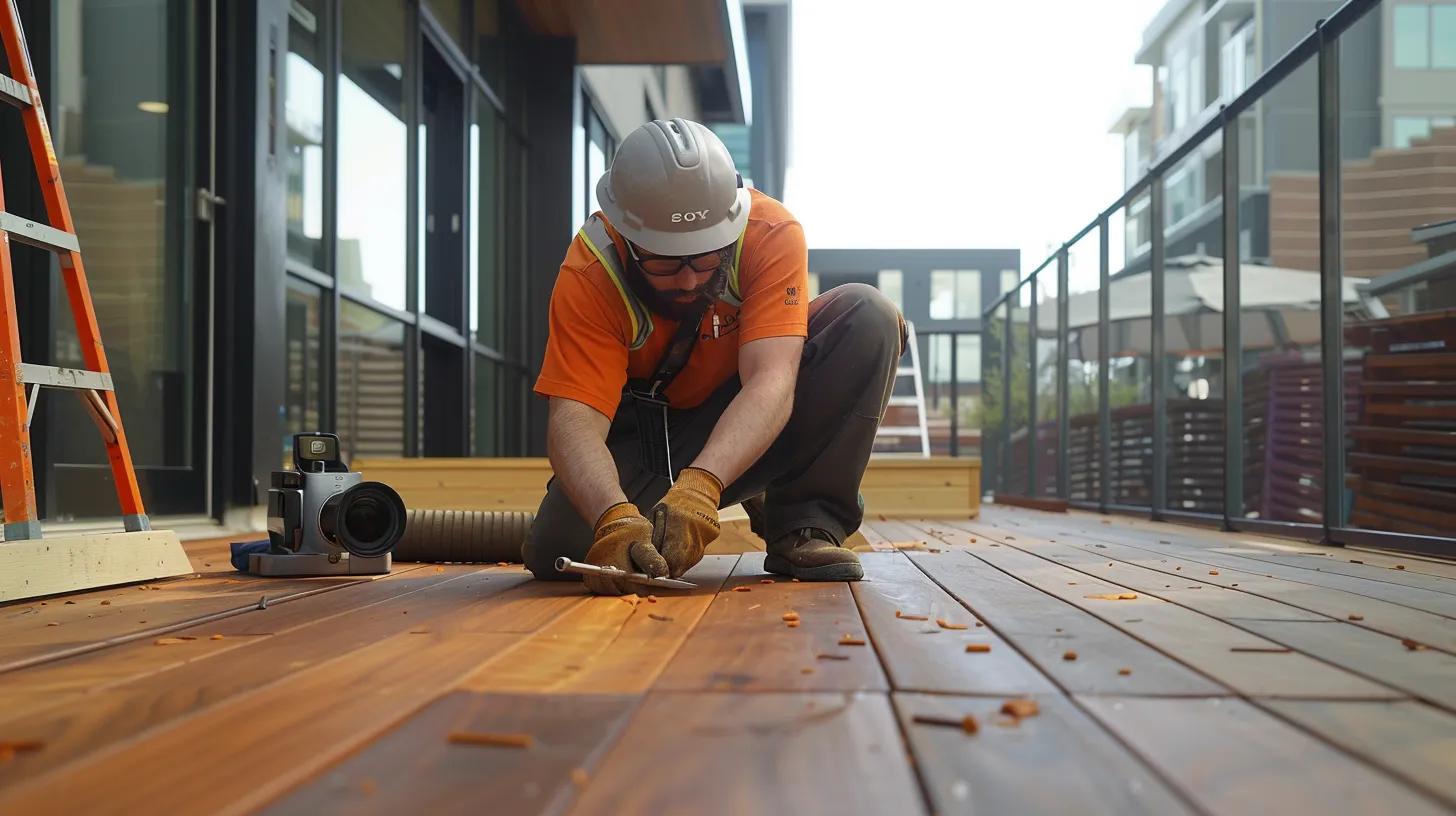
While DIY deck care can handle basic upkeep, some tasks are better left to professionals. Atlanta Hardscape Kings offers expert-level repairs, detailed inspections, and high-quality service backed by solid warranties, making them a reliable option when your deck needs more than a quick fix.
- When to Hire a Professional: If your deck has widespread rot, sagging boards, or signs of structural damage, it’s time to bring in a pro. These issues often go deeper than they appear and could lead to serious safety concerns if ignored. A licensed technician can spot underlying problems and recommend the right fix before they get worse.
- What Makes a Good Deck Maintenance Company: Not all deck companies are created equal. Look for a team with a strong local track record and experience handling Georgia’s heat, humidity, and seasonal shifts. A good company should offer written estimates, detailed inspection reports, and clearly explain what work is needed. Licensed professionals with solid customer reviews and a warranty on their work are key signs you’re dealing with someone trustworthy.
- Why Professional Inspections Matter: A professional eye can spot things you might miss, like water damage under the surface, early signs of insect activity, or weak spots in the structure. These kinds of inspections are especially important before or after winter, during rainy seasons, or if your deck is more than a few years old. Catching small issues early often means avoiding big repairs later.
- What to Expect on Cost: Hiring a pro does cost more upfront, but it can save you money in the long run. Preventative care keeps your deck in good shape longer and avoids expensive emergency repairs. Some companies offer seasonal service packages that include inspections, minor fixes, and cleanings.
- Keeping It on a Schedule: It’s a good idea to schedule professional maintenance once or twice a year, usually in spring and fall. This routine care helps keep your deck safe, clean, and ready to use year-round.
Partnering with experienced pros like Atlanta Hardscape Kings helps take the guesswork out of deck care and keeps your outdoor space looking and performing its best.
Frequently Asked Questions
Q: How often should I inspect my deckfor damage? A: Inspect your deck at least twice a year—once in the spring after winter and once in the fall before winter. Early detection of wear, moisture buildup, or pest damage can prevent costly repairs.
Q: What is the best cleaning solution for an Atlanta deck? A: A mild, eco-friendly detergent paired with a sponge or soft brush works best. Test on a small area first and avoid harsh chemicals that may strip protective sealants.
Q: Can I use a pressurewasher on my deck? A: Yes, but use a low-pressure setting with a fan-type nozzle and maintain a safe distance to avoid damaging the wood and sealants.
Q: How do I know when to reapply stain or sealant? A: Reapply when you notice fading color, water damage, or mold and mildew. Typically, this is every two to three years, depending on usage and weather exposure.
Q: What are the advantages of hiring professional deckmaintenanceservices? A: Professionals provide expert assessments, specialized tools, and thorough cleaning and repair services that can reveal hidden issues. Their work is often backed by warranties to ensure long-term deck safety and durability.
Q: How does Atlanta’s climateaffect decklongevity? A: The variable climate—with high humidity, hot summers, and occasional winter moisture—can promote mold, mildew, wood rot, and degradation of finishes. Regular maintenance including cleaning, sealing, and inspections is critical to prolonging deck life.
Protect Your Atlanta Deck Year-Round: Final Checklist
Atlanta deckmaintenance requires a season-by-season approach to counteract local climate challenges. Regular inspections, deep cleaning, timely repairs, and proper sealing are essential to keeping your deck safe and attractive. Following these expert recommendations and using professional services when necessary will protect your investment and ensure a welcoming outdoor space throughout the year.
Keeping your deck in top shape through each season not only preserves its beauty but also extends its lifespan, ensuring safe and enjoyable outdoor living all year round. From routine cleaning and sealing to timely repairs, these maintenance steps protect your investment against Atlanta’s weather extremes. Trust Atlanta Hardscape Kings to provide professional deck services and guidance tailored to your deck’s needs. Call us at (470) 606-7895 or visit our website to get a free estimate—let’s keep your deck looking and performing its best season after season!


